In Qatar, Christianity grows on the fringes
For 10 years, the main Church of Qatar has been a sanctuary for a plural community composed of Asian, Arab, African and Western Christians.
Hidden behind a grey enclosure wall in the far rocky outskirts of Doha, Qatar's capital city, the Church of Our Lady of the Rosary is accessible only after a security check.
"It has been secured in 2015 when a suicide attack targeted a place of worship in Kuwait," said Rallye S. Gonzaga, the Filipino parish priest.
Built in 2008 on a land donated by Qatar's former emir Sheikh Hamad bin Khalifa al-Thani, Our Lady of the Rosary is the country's first church since pre-Islamic times. It stands as a lively symbol of the growing non-intrusive Christian expatriate population in Qatar, a Muslim-majority country influenced by the Wahabi thought, a conservative movement within Islam's Sunni branch.
"At the time of the inauguration, the Church seated in the middle of nowhere. There was not even a road to reach it from the highway," remembered Sunita Mascarenhas, an Indian Christian who has been living in Doha for 27 years.
100,000 believers
In addition to a spacious praying area that can accommodate simultaneously up to 2,000 believers, the complex has gradually expanded to include Coptic, Anglican, Greek-Orthodox, Syrian-Orthodox and Pentecostal churches.
"On Friday, up to 100,000 believers attend our masses," Gonzaga told The New Arab.
The Maronite community, one of the largest Eastern-rite communities of the Roman Catholic church, meets regularly in one of the two adjacent chapels.
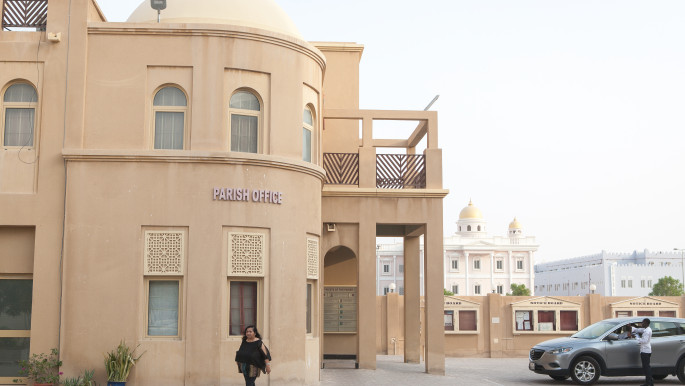 |
|
| View of the Parish office at the Catholic Church of Our Lady of the Rosary, Doha, Qatar [Sebastian Castelier] |
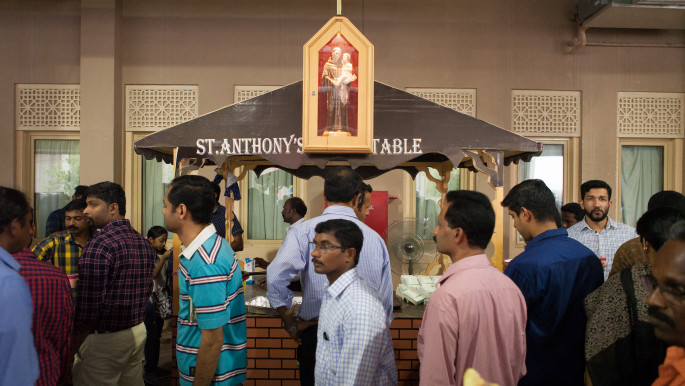 |
|
| Believers pass by a restaurant on their way to perform prayers at the Catholic Church of Our Lady of the Rosary, Doha, Qatar [Sebastian Castelier] |
From ten in the morning to ten in the evening, masses keep rolling in Tagalog, a language spoken in the Philippines, English, Arabic, Spanish, French, Malayalam and Tamil, two Indian languages spoken respectively in Kerala and Tamil Nadu.
"The Filipino community predominate on the benches of the church, but we also have believers from India, Sri Lanka, Egypt, Lebanon, the UK, America, France, Spain etc. I have to adapt to many nationalities," said Gonzaga.
In the inner courtyard, community events are frequently held. Today, under a burning sun, a speaker mixes some 'Christian pop' and turn the space into a dance hall where a handful of children move under the gaze of their parents.
"Every Friday, we organise a different event and today is our children's day," said Bernard Balomares, a Filipino national in charge of catechism classes offered by Our Lady of the Rosary to more than 1,400 children every year.
With a hurried step, he slaloms through the dozens of parents waiting in the corridors of this three-storey building resembling a formal school.
"Before 2008, it was difficult to transmit our values and religion for the next generation, the construction of the Church really made a difference," said Balomares, one of the sixty employees.
 |
|
 |
|
| Believers perform prayers at the Catholic Church of Our Lady of the Rosary [Sebastian Castelier] |
According to the US State Department, Islam is the state religion in Qatar, although Muslims account for less than half of the total population.
Other religious groups, including Hindus, Christians and Buddhists, are guaranteed by the Constitution the "freedom to practice religious rites". Yet, missionary activities and proselytism are subject to heavy jail sentences.
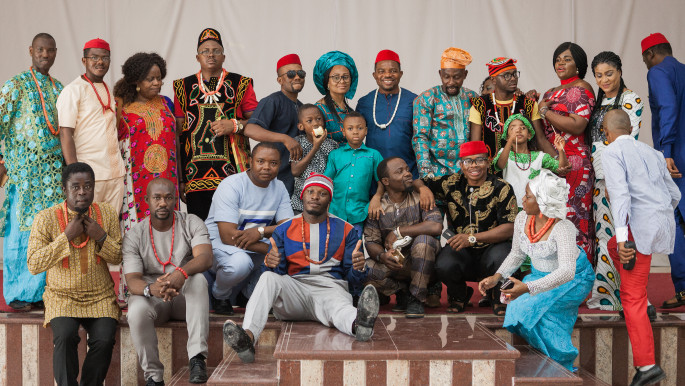 |
|
| The Christian African community living in Qatar gather to celebrate the Feast of St. Augustine in the Catholic Church of Our Lady of the Rosary [Sebastian Castelier] |
"I miss our closeness"
Sunita and her husband Michael Mascarenhas, who have lived in Qatar since the '80s, have a vivid memory of the difficult times.
"Back then, there was no Church in Qatar and group prayer was forbidden, so we had to organised secret prayers at the house of a member of the community," Michael said.
In those 'clandestine days', believers afraid to reveal their faith in particular to Muslims people had to wait for a last-minute phone call to know where and when the prayer would take place.
 |
|
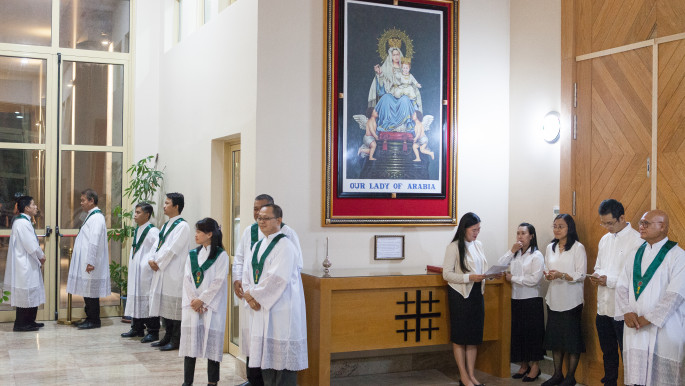 |
|
| Members of the religious staff at the Catholic Church of Our Lady of the Rosary [Sebastian Castelier] |
The early 2000s marked a turning point as the Qatari government allowed Christians to gather to practice their faith.
"We rented a house to pray together in Ras Abu Aboud, a suburb in the East of Doha. Like a family," Sunita said.
Times have changed and nobody regrets the secrecy, blessing the permission to pray in a country per nature Islamic. However, Sunita easily admits that the atmosphere has changed.
"Back then, everyone would pray together while it is now a collection of small islands. Each community attend its own mass and we barely mix, except during the common celebrations, like Christmas," she said.
After the exponential growth of the Filipino community in Qatar, it is technically not feasible to accommodate everyone in a single prayer hall.
Notwithstanding the loss of 'family spirit', Sunita and Michael find in this energy-rich country a particularly stirring ground that they consider as unique.
"Back home in India, I don't find this lively atmosphere, human and spiritual closeness," she said, praising the liveliness of Our Lady of the Rosary.
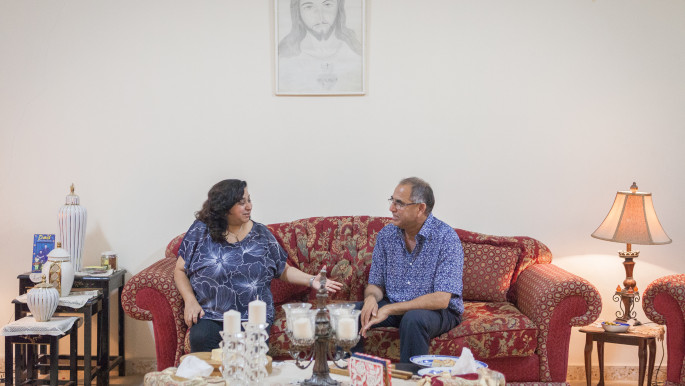 |
|
| Portrait of Sunita and Michael Mascarenhas, both Indian Christian who have lived in Qatar for decades [Sebastian Castelier] |
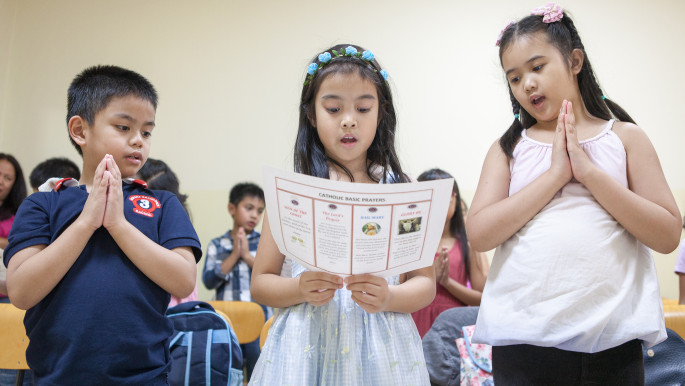 |
|
|
Children of different nationalities attend Catechism classes at the Catholic Church of Our Lady of the Rosary [Sebastian Castelier] |





 Follow the Middle East's top stories in English at The New Arab on Google News
Follow the Middle East's top stories in English at The New Arab on Google News


